There are over 25 domestic duck breeds. If you’re a beginner looking into buying ducks for the first time (or even if you already have experience with ducks), the options can be overwhelming. How do you know which breed is best for you?
This is a carefully curated list of the duck breeds I’ve deemed to be best for pets: breeds that are best for beginners, most likely to have a friendly temperament, and most suitable to being a pet. I’ve also highlighted some breeds that are small (because many prospective pet owners have limited space or otherwise like the idea of a small duck), and breeds that lay well, because most people would like plentiful eggs as well. If you, contrarily, don’t want to eat eggs, you may want a breed that lays minimal eggs (or is less likely to have egg-related health problems), so I’ve also listed some breeds that don’t lay much.
However, this list isn’t perfect and never will be, for several reasons. One, which duck breed or breeds are best for you depends on your circumstances.
Two, “XXX breed is friendly” is always a gross generalization.
Most pet owners want a friendly duck. Maybe even a cuddly one. Since friendliness is a priority for many people, and some breeds are more high-strung and naturally skittish than others, I’ve tried to highlight “friendly” breeds.
But it doesn’t mean much. Whether a duck is friendly or not primarily depends on how it is raised, not its breed.
Ducks also are not naturally super friendly. They are prey animals, and they don’t seek out human attention like dogs. For a duck to be friendly, it needs to receive a lot of human attention. Even then, not all hand-raised ducks are friendly.
Three, breed really doesn’t matter much. Ducks are ducks.
There are no bad duck breeds.
All duck breeds make good pets.
Ducks aren’t like dogs. Dog breeds differ in characteristics, temperament, and behavior far more than duck breeds. A Great Pyrenees would be completely incompatible with many families’ lifestyles, but ideal for others. But if you like one duck breed, you’ll probably like most of the others, too.
So I think this list is kind of pointless. Maybe read my list of top 10 things you should know before getting a pet duck instead.
Still, there are some differences between breeds and some points worth noting. I’ve narrowed the list of 25+ breeds down to 10 for you. Sort of.
#1: Welsh Harlequin
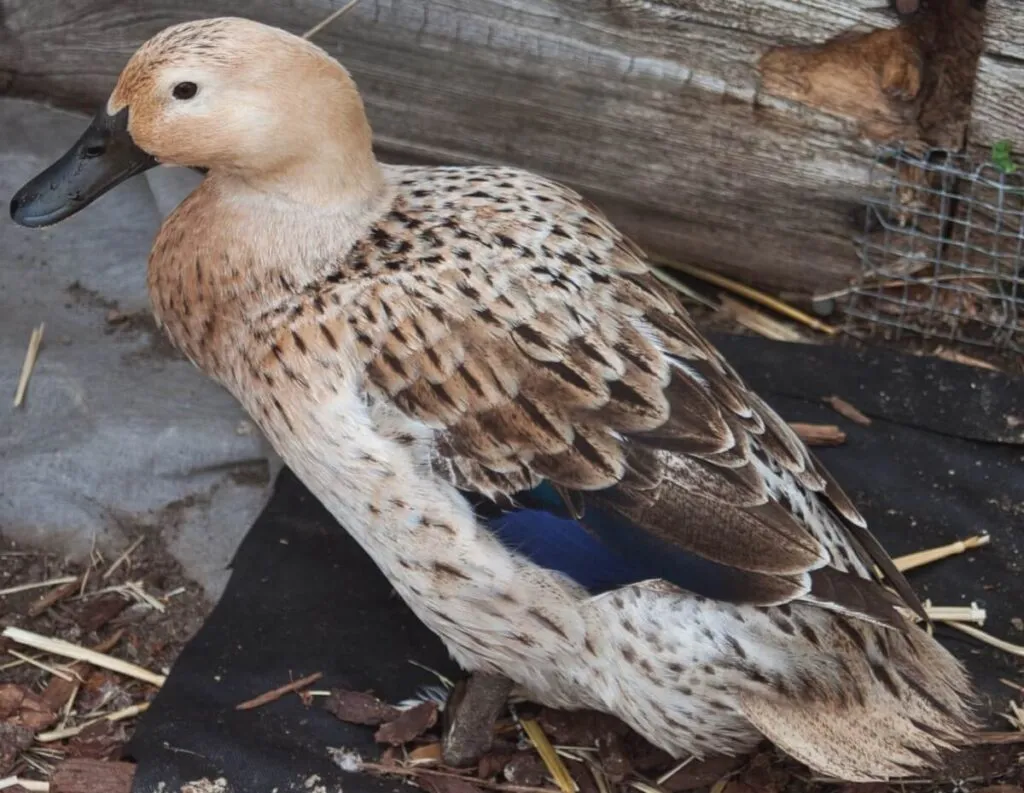
Photo credit: “Here’s Mama! She’s a layer too!” (CC BY-NC 2.0) by Steve Wedgwood
Advantages
- Friendly, calm
- Great layers
- Don’t fly
- Great foragers
Disadvantages
- None really
I won’t say there’s any #1 breed that absolutely, indisputably makes the best pet, but if I really had to pick just one, it would be the Welsh Harlequin. A wonderful breed all around, they’re particularly suitable for pets due to typically being docile and easy to tame. Metzer Farms reports that their Welsh Harlequins seem to be the calmest birds on their farm, and many Welsh Harlequin owners love their personality and laid-back temperament.
Welsh Harlequins are also fantastic layers, with good strains producing 240-330 eggs a year. With this breed, you’ll only need a few birds to receive all the eggs you need.
They’re classified as a light breed, weighing 4.5 to 5.5 pounds. For many pet duck owners, they’re the perfect size, neither too large nor too small.
They don’t fly, and they’re good foragers, hardy, and great broodies and mothers.
Another cool advantage of the Welsh Harlequin is that male and female ducklings are often distinguishable as hatchlings. It isn’t always possible to reliably tell the difference, but they are still the only duck breed where sexing ducklings by outward characteristics is (somewhat) possible. Read more about sexing Welsh Harlequins here.
Although they are not known for being particularly loud, it’s still worth noting that they’re not quiet. Like other duck breeds, most individuals will quack a lot, and this may bother some people.
Welsh Harlequins top our list of best duck breeds for pets primarily because they have no real disadvantages. You won’t go wrong choosing this beautiful breed.
Read more about the Welsh Harlequin duck.
#2: Pekin
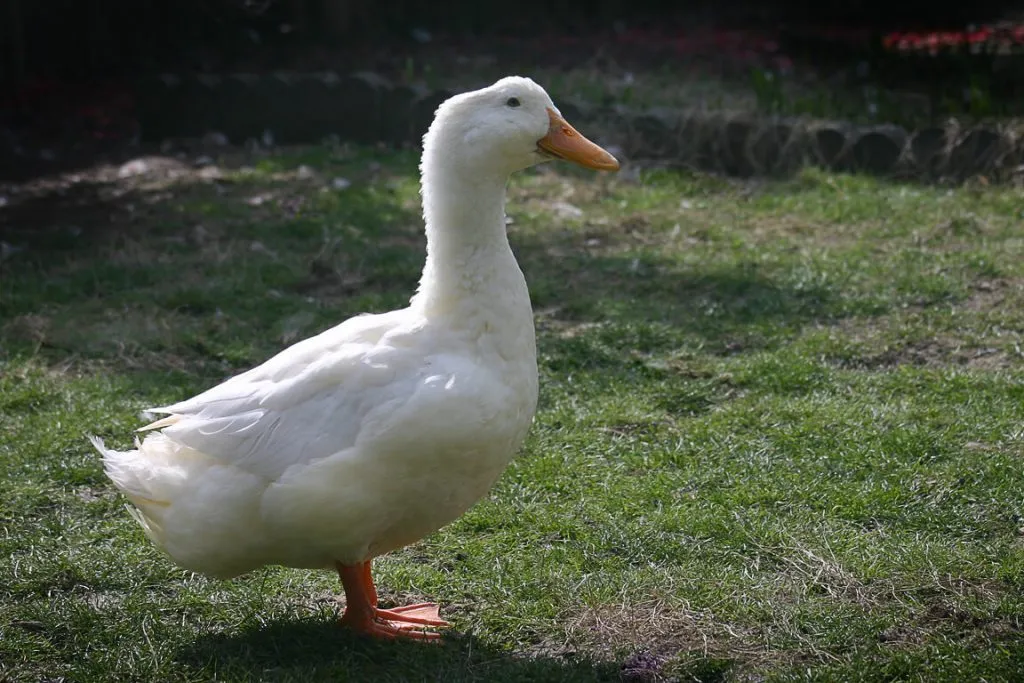
Photo credit: “My boy Flapper” (CC BY-NC-ND 2.0) by tifotter
Advantages
- Popular
- Friendly
- Good layers
- Don’t fly
Disadvantages
- Large
- Noisy
- Short lifespan
- Health problems
The Pekin tops many lists of “best duck breeds for pets.” It’s easy to see why: they’re easy to find, beautiful, and extremely friendly. They’re probably the friendliest, on average, of all duck breeds.
But I’ve ranked them as second on my list because, even though they’re popular and everyone loves them, they have a couple of major drawbacks that people often overlook or are unaware of—and it comes back to bite them later. For one, Pekins, Jumbo Pekins in particular, tend to have short lifespans. Regular Pekins usually live 5-10 years; Jumbo Pekins only live 1-5 years on average.
Secondly, Pekins are prone to a variety of health issues, due to their fast growth rate and heavy weight:
Leg and joint issues. Many birds are too large for their legs and become lame or crippled. Niacin supplementation is a must for these birds.
Obesity. They become overweight easily, so they need to be kept on a diet.
Egg binding and other laying issues
Bumblefoot
Again, Jumbo Pekins are most susceptible due to their unnatural conformation. I don’t recommend Jumbo Pekins for pets. They are too large for their own good and often can’t live comfortable adult lives.
Many Pekin owners find them to be very noisy.
If you want to try hatching, be aware that Pekins are very bad mothers, so you will likely need an incubator or a broody of another breed in order to hatch ducklings. If, on the other hand, you don’t want a duck that will go broody, this may be an advantage.
They’re very good layers, though. Production varies by strain, but the average Pekin duck will lay 125-225 eggs a year.
Pekins still make great pets and are adored by many duck owners, but you do need to be aware of their potential health problems and prepared to deal with them.
Read more about the Pekin duck.
#3: Muscovy
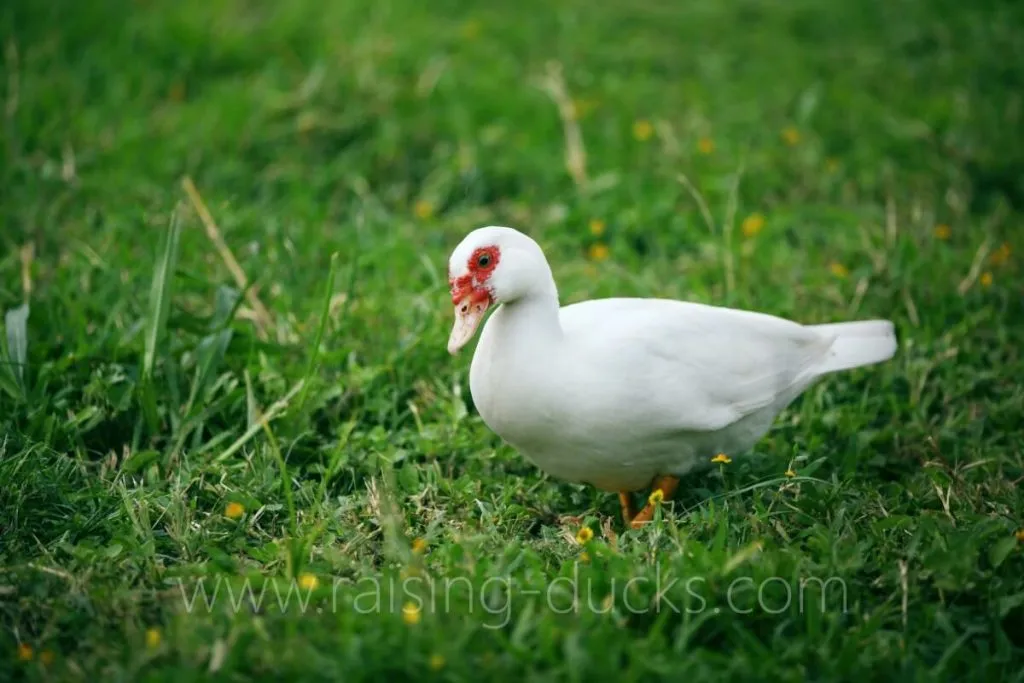
One of my Muscovy ducks foraging.
Advantages
- Quiet
- Friendly
- Intelligent, have a lot of personality
- Great foragers
- Come in many colors
Disadvantages
- Some find them ugly
- Strong, have sharp nails
- Can fly
- Don’t lay much
- Not cold hardy
The Muscovy duck is one of those things that most people either love or hate, with few having a neutral stance.
The primary advantage of Muscovies for pets is their quietness. They are the only duck breed that is truly quiet. Instead of quacking, females produce a gentle, musical cooing or trilling sound, while drakes have a hoarse hiss. If you have close neighbors or otherwise don’t want a noisy duck, Muscovies may be your best choice.
Muscovies are also considered the smartest duck breed. They are often thought to be more intelligent than Mallard-derived ducks and chickens, which might be why many Muscovy lovers talk about how quirky and full of personality they are. They also tend to be calm and friendly.
Many duck breeds come in only one color, but Muscovies are one exception. Some Muscovy colors include black, white, blue, chocolate, blue fawn, lavender, bronze, and silver. They can also display several patterns, including pied, barred, and rippled.
They can fly. However, wing clipping is a simple, painless procedure. They also go broody frequently and are great mothers, but they’re mediocre layers, only producing 80-120 eggs a year.
Some people are turned off by their looks, particularly by their red, lumpy “mask,” known as “caruncles.” If this bothers you, look for individuals with light caruncling. Caruncle growth is a genetic trait. Some families and strains of Muscovies have heavy caruncles; others have almost none.
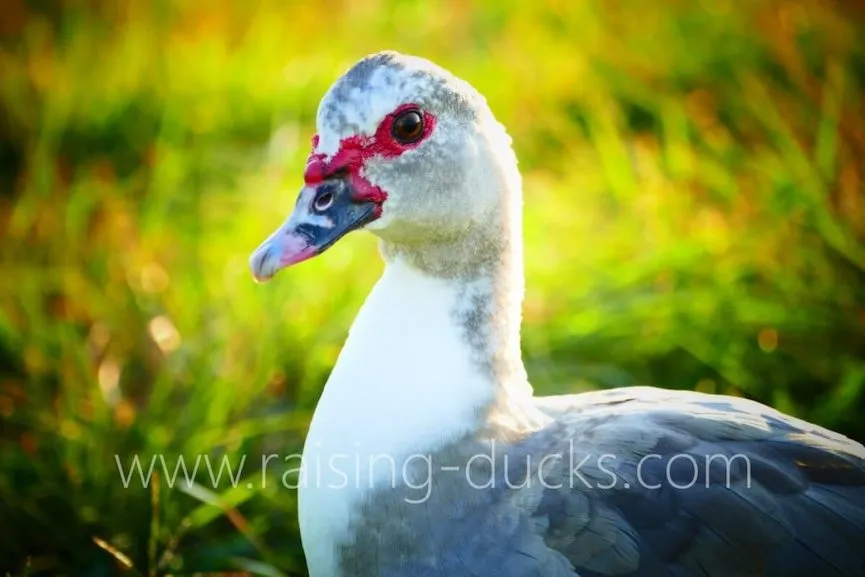
One of my Muscovies, Sweet Pea, who has very mild caruncling.
Muscovies are also very large, with females weighing 5.5-9 pounds and males weighing 9-15 pounds. They are strong, with powerful wings and razor-sharp nails. Hence, they can be difficult to handle, especially the drakes, which may be a consideration if you’re new to ducks or have kids. They also need a lot of space, especially as they are an active breed that loves foraging.
If you live in a very cold area, you may want to consider a different breed. Muscovies, a tropical breed, are prone to frostbite in cold weather.
Many Muscovy owners are diehard Muscovy fans and will vehemently declare them to be The Best duck breed. Even if quietness isn’t a priority for you, Muscovies are still a wonderful, lovable breed worth considering.
Read more about Muscovy ducks.
#4: Call

Photo used with permission from Beau McLean at Duck Creek Farm.
Advantages
- Small
- Very cute
- Very, very cute
- Very, very, very cute
- Come in many colors
Disadvantages
- REALLY noisy
- Don’t lay much
- Not easy to hatch
- Fragile, not ideal for kids
- Can fly
There is a general consensus that Call ducks are louder and noisier than any other breed. If you have close neighbors or don’t want a noisy breed, either don’t get Calls, or get only males. Males are quieter and make just as good pets as females, except that they don’t lay eggs.
Call ducks aren’t useful as egglayers to begin with, as they only lay around 30 small eggs a year. However, this means they’re also less likely to have egg binding or other egg-related health issues.
There is also, perhaps, a general consensus that Calls are the cutest of all duck breeds. They just look like stuffed animals, don’t they? Their round cheeks and chubby bodies are irresistible. However, as cuddly as they look, they aren’t generally the friendliest breed. Some Calls are extremely friendly and will tolerate petting or even being held; others are more standoffish and don’t like being touched.
Calls are another breed with many color variations, such as apricot, black, blue bibbed, blue fawn, buff, butterscotch, chocolate, gray, magpie, pastel, silver, snowy, and white.
If you’re a beginner hatcher and want to start your flock with hatching eggs, Calls may not be the best breed, as they are more difficult to hatch than other breeds. Their hatch rate is low and they are more likely to have complications or die while hatching. This is partly due to their unnaturally short bills, which makes it difficult for them to pip (crack the shell). “Show quality” individuals tend to have more deformed bills.
Calls are one of the smallest duck breeds. Since they’re so tiny and fragile, they may not be the best breed for kids. Ducklings can be crushed easily, and adults can be injured if they’re dropped or not handled well.
Buttttttt…how can you resist a pet Call duck?
View this post on Instagram
Read more about the Call duck.
#5: Blue Swedish

Photo credit: “Blue Swedish Duck” (CC BY-NC-ND 2.0) by budgora
Advantages
- Docile, friendly
- Good foragers
- Don’t fly
Disadvantages
- None really
The Blue Swedish duck is an old heritage breed with beautiful smoky blue feathering and a white bib.
Although blue is the only show-eligible color, Swedish ducks actually don’t breed true to color. Many individuals are black or silver.
They’re fairly large birds, weighing 7-9 pounds, and modest layers, producing 100-150 eggs per year. Since they’re not particularly favored for either meat or eggs, they’re primarily used for pets, exhibition, or general farm/backyard birds.
Swedish ducks are also active, good foragers, extremely hardy, and very tolerant of cold weather. They make great backyard birds, but do better if they have a nice amount of space.
As for temperament, they’re typically calm and docile, which makes them suitable for pet owners and new duck owners.
They’re not known to be particularly noisy, but neither are they particularly quiet.
They’re an endangered breed, but they’re well-loved among pet owners and backyard duck owners, thanks to their beauty and lovable personality.
Read more about the Blue Swedish.
#6: Cayuga

Advantages
- Usually fairly quiet
- Don’t fly
Disadvantages
- None really
Cayugas are a beautiful, popular breed, best known for their stunning iridescent green feathering. I considered listing “beautiful” as one of their advantages, but then I’d want to list it for every other duck breed as well, because I think all duck breeds are beautiful. Still, their glossy feathering is one of the main reasons people are drawn to the Cayuga.
Many people find their Cayugas to be quieter than other breeds. However, there are also people who say their Cayugas are the loudest in their flock.
They don’t tend to be the friendliest. Metzer Farms finds them to be one of the most nervous breeds on their farm, and many Cayuga owners say they tend to be flighty and skittish. However, plenty of other Cayuga owners find their birds to be friendly and calm.
Cayuga ducks produce 100-150 eggs a year, which isn’t spectacular, but is enough for many people. They’re large, weighing 7-8 pounds, so they’re considered a dual-purpose breed and were the most common meat duck in the US prior to the introduction of the Pekin. They are also good broodies and mothers.
Cayugas also tend to rank high on lists of best duck breeds for pets. I’ve ranked them lower because although they are a great breed, there are a lot of other underappreciated breeds that are just as good for pets, but don’t receive as much attention because they’re rarer. But Cayugas still make wonderful pets and you won’t go wrong with them.
Read more about the Cayuga duck.
#7: Rouen
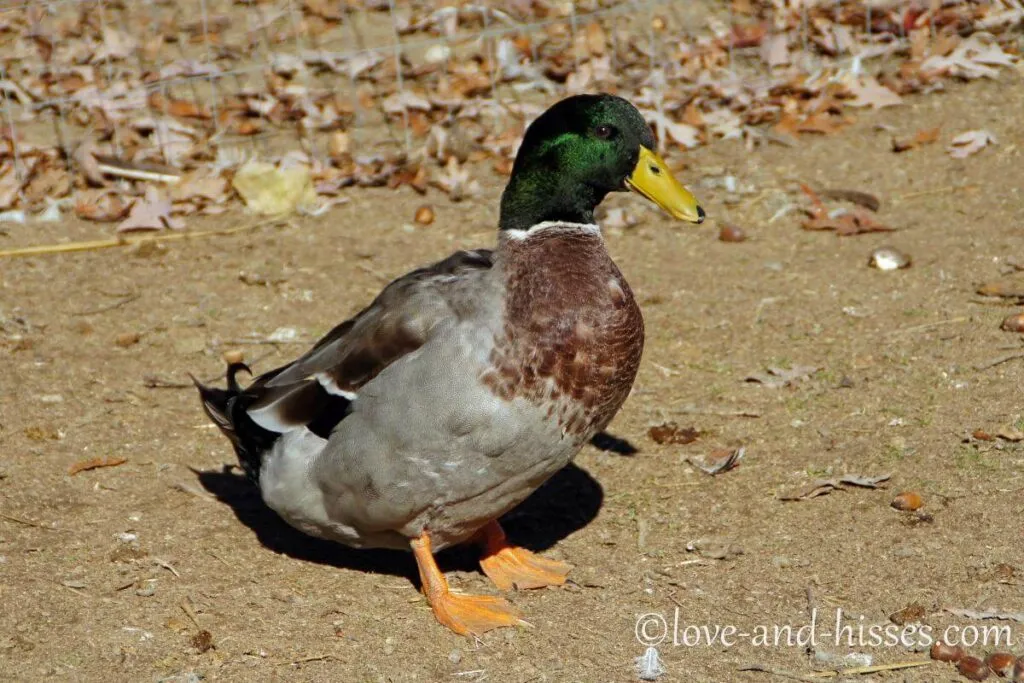
Photo credit: “2013-11-13-06” (CC BY-NC-ND 2.0) by RobynAnderson
Advantages
- Friendly, calm
- Popular
- Don’t fly
Disadvantages
- Not great layers
- Noisy
There are two types of Rouen duck: the “standard” or exhibition Rouen, and the production or utility Rouen.
The Standard Rouen is a huge bird, weighing 9-11 lb, raised mainly for meat or exhibition. Due to their heavy frame and large keel, they don’t like walking much and aren’t good foragers. They are prone to leg issues and bumblefoot. They also don’t lay prolifically (35-125 eggs a year) and often have difficulty breeding. They’re not bad for pets if you want a large, calm bird and aren’t interested in eggs, but they need plentiful access to swimming water. They’re fairly rare, much less common than the production/utility Rouen.
Most ducks labelled “Rouens” are production Rouens. These birds are a little bit smaller (but still a large breed, weighing 5-8 pounds), lay more eggs (about 140-180 per year), and are more active (though they’re generally not standout foragers). They’re popular for pets, as they’re easy to find and typically have a calm disposition.
If you like the look of the Mallard, Rouens look nearly identical (except that they’re larger) but don’t fly and tend to make better pets. Overall, Rouens are a solid all-around breed. I, personally, think they’re a bit overrated. Feel free to quibble.
#8: Buff Orpington
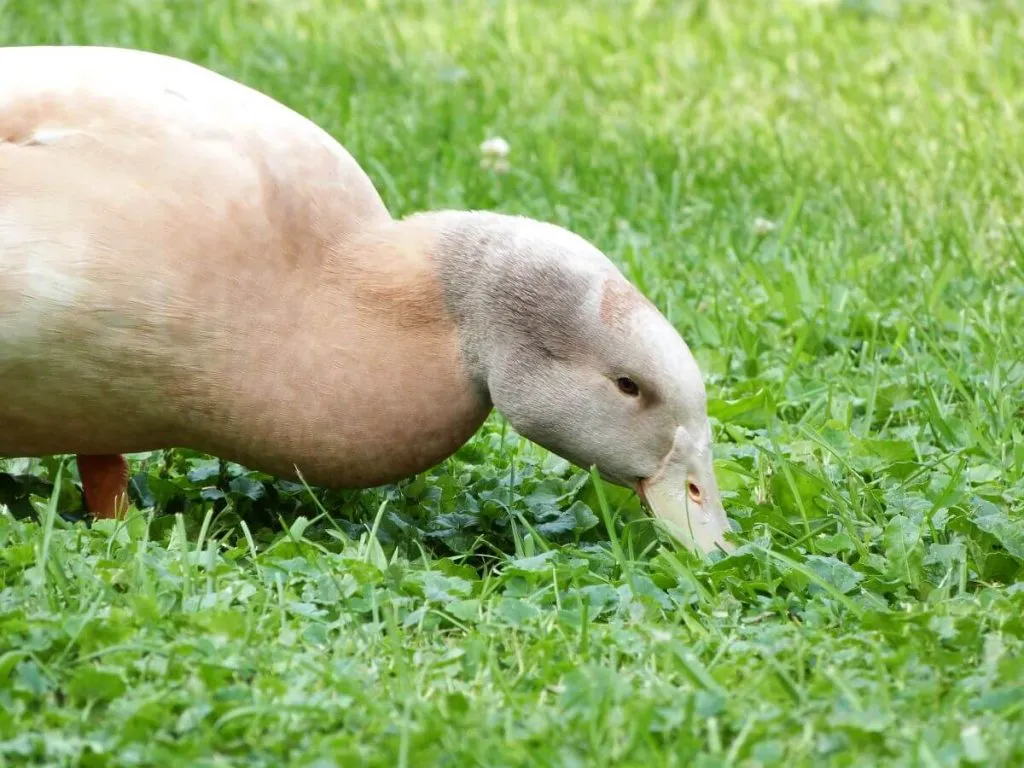
Photo used with permission from Kayli at thegaagirl.blogspot.com.
Advantages
- Great layers
- Excellent foragers
- Don’t fly
Disadvantages
- Can be difficult to find/expensive
Looking for a more unusual breed? Consider the Buff Orpington duck.
I don’t know of anyone who keeps Buff Orpington ducks exclusively as pets, but they’re favored as backyard/homestead birds and would make just as good, if not better, pets than Cayugas and other more popular breeds.
They’re good egg producers, laying 150-220 eggs a year. They weigh 5-8 lb, don’t fly, and are decent mothers. They’re also active birds that forage well.
This is a beautiful, underrated breed that deserves more attention. They’re at risk of disappearing, so it would be great if more people would keep them.
Read more about the Buff Orpington duck.
#9: Australian Spotted
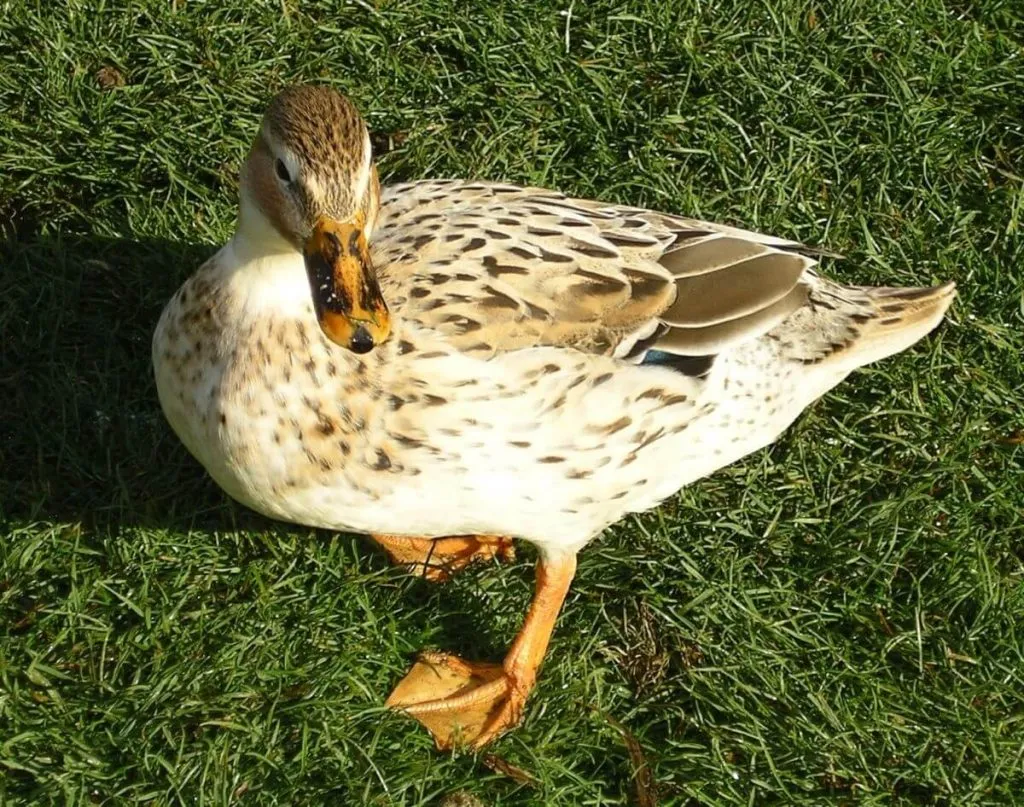
Photo used with permission from Beau McLean of Duck Creek Farm.
Advantages
- Small
- Hardy
Disadvantages
- Noisy
- Can fly
- Difficult to find/expensive
- Not great layers
Another rare breed that deserves a mention is the Australian Spotted. After all, they’re a pet breed. Most other breeds on this list are generally considered “meat ducks” or “layer ducks,” but the Australian Spotted is a bantam used only for pets and exhibition.
Australian Spotted ducks are extremely hardy and good foragers. They weigh 2-2.2 lb, a little larger than most other bantam breeds, and lay 50-125 eggs a year, a little more than most other bantam breeds. Like other bantams, they’re very noisy and can fly.
If you want a small duck or are interested in Calls, consider the Australian Spotted instead! They deserve more love.
Read more about the Australian Spotted duck.
#10: Any breed
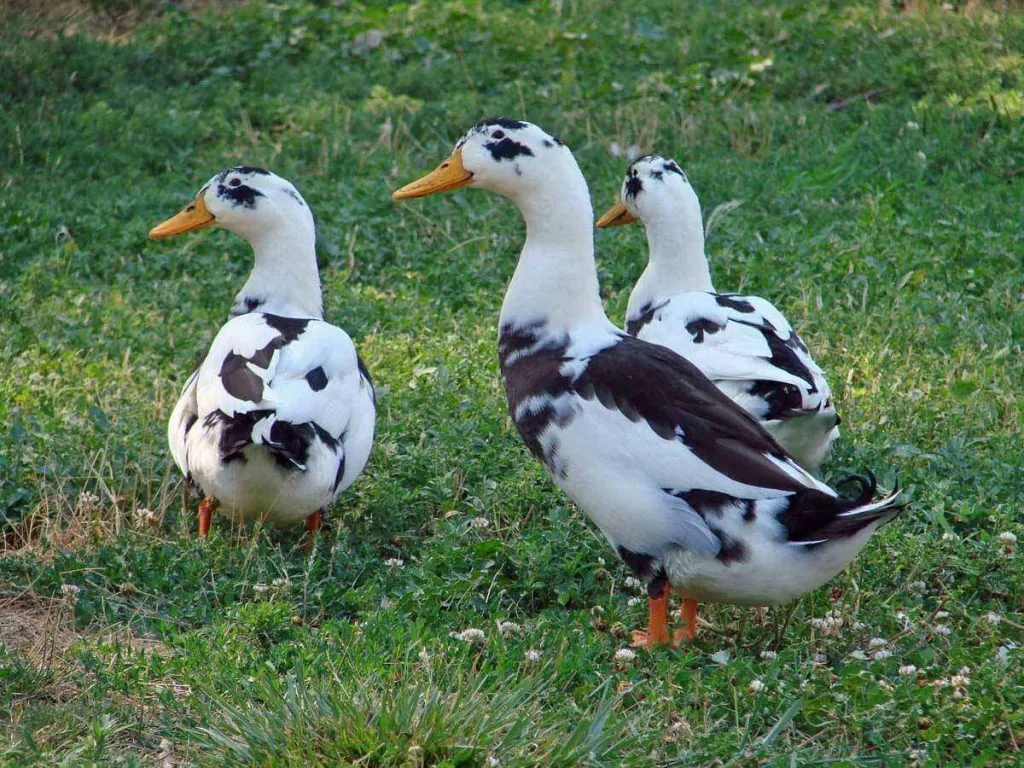
Three lovely Ancona ducks. Photo credit: “DucksGrownUp” (CC BY-SA 2.0) by Miles Away Farm
I give up. The Buff Orpington, at #8, is just as good as the Ancona. The Australian Spotted is just as good as the East Indies.
Here are some honorable mentions that would also make great pets:
Worst breeds for pets
Here are three more great duck breeds.
#1: Khaki Campbell
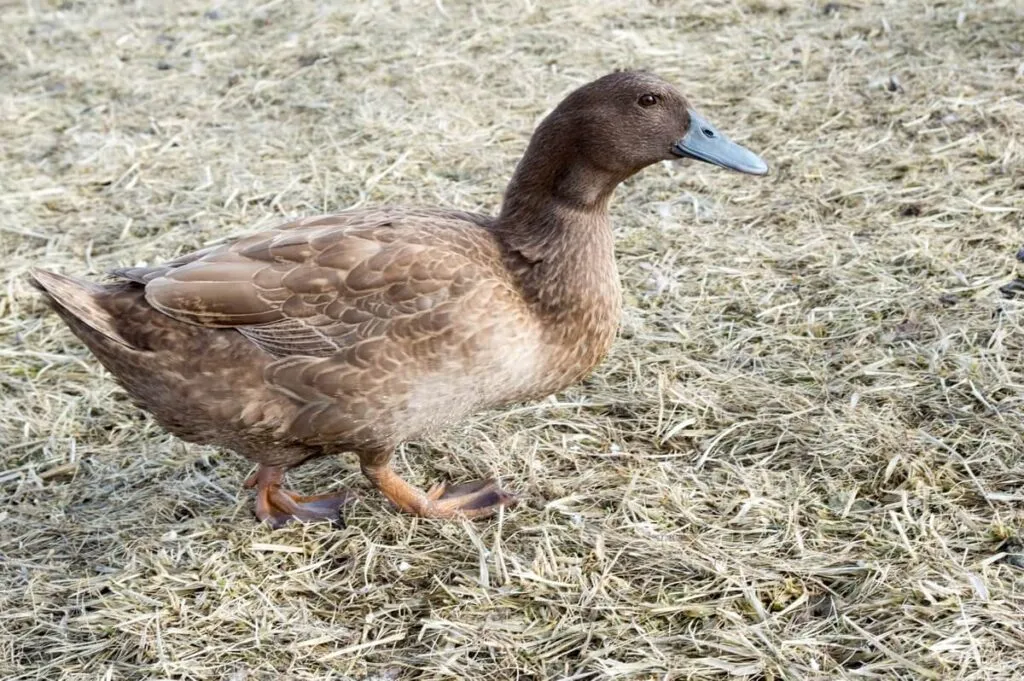
Photo credit: “Khaki Campbell Duck” (CC BY-NC-ND 2.0) by Tina Bell Vance
Advantages
- Phenomenal layers
- Don’t fly
Disadvantages
- Often skittish and nervous
- Not good mothers
The Khaki Campbell is an egg machine, producing an incredible 250-340 eggs a year. If you want eggs, Campbells are one of the best breeds available.
Due to their nervous temperament, however, they aren’t as suitable for pets as some other breeds. Khaki Campbells tend to be skittish, easily spooked, and difficult to tame. They function best in a calm, low-stress environment, without too much stimulation. If you want your Khaki Campbells to be friendly, you’ll have to raise them carefully, and even then, they’re unlikely to be cuddly.
This isn’t to say that they make bad pets, again. Some individuals are quite friendly, and if they’re hand-raised with frequent gentle attention, they can still be good pets. They just tend to be more difficult to tame. If you’re a beginner and friendliness is a priority for you, you may prefer starting with a different breed of duck.
On the good side, Khaki Campbells are usually not excessively loud, they don’t fly, and, of course, their laying ability is nearly unmatched.
They don’t make good broodies or mothers.
#2. Indian Runner
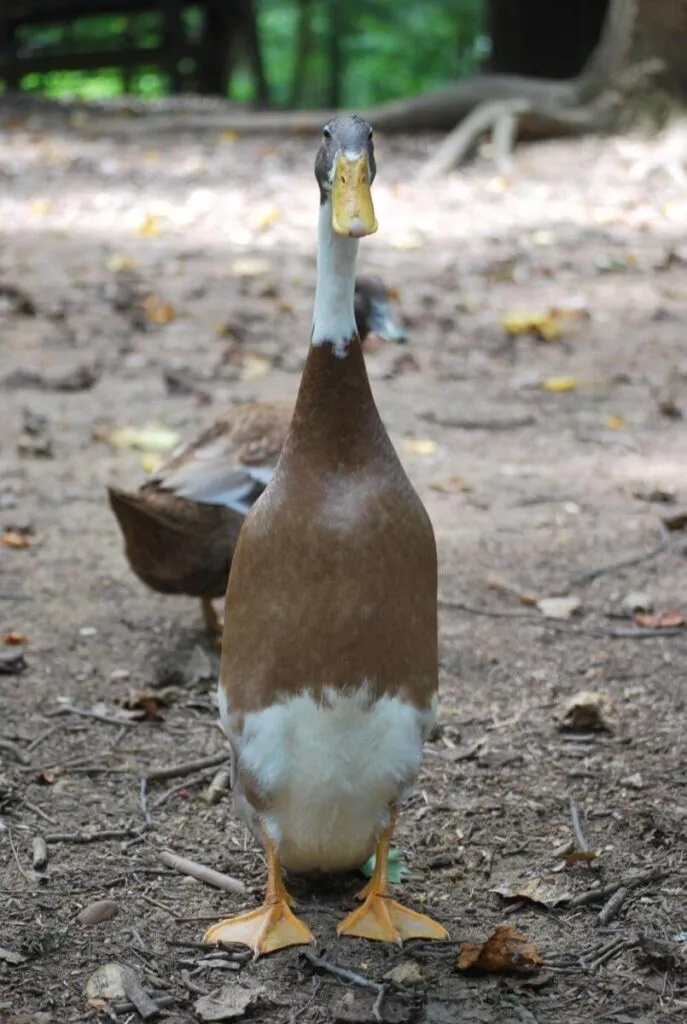
Photo credit: “20130804_Runner” (CC BY 2.0) by Head MooseHerder
Advantages
- Come in many colors
- Entertaining
- Good layers
- Don’t fly
Disadvantages
- Noisy
- Not the friendliest, often skittish
- Need a lot of space
Like Khaki Campbells, Runners tend to have a nervous temperament. They are high-strung and easily startled, so you will have to be very patient with them if you want them to be friendly pets. They’re best known for their unique, upright posture and slim build, resembling a bowling pin. As their name suggests, they love to run.
They’re extremely active and fantastic foragers, which is one reason they don’t make the best pets, especially not for people in urban areas or with limited space. Runners need a lot of space to roam, run, and forage. They won’t be very happy in a confined run.
Another cool thing about Runner ducks is that they come in more colors and patterns than any other duck breed: black, chocolate, buff, gray, penciled, cumberland blue, apricot dusky, fawn, fawn and white, white, silver, trout, blue trout, and apricot trout.
They’re a light breed and lay up to 300 eggs a year. They typically are bad mothers.
If you have plentiful space and can handle their timid, excitable temperament, Runner ducks make great pets, but they’re not ideal for everyone.
#3: Crested
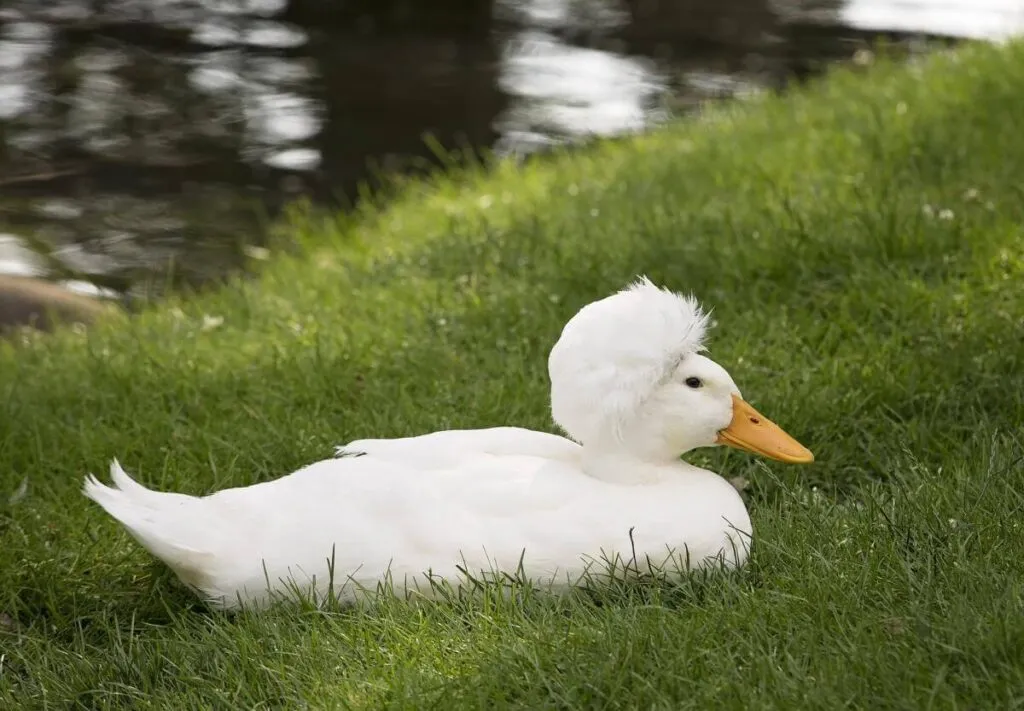
Advantages
- Cool-looking
Disadvantages
- Unethical to breed
- Not good for beginners
- Nervous temperament
The main attraction of the Crested duck is, of course, the unique, fluffy crest on the back of their head.
Unfortunately, this crest is caused by a genetic mutation resulting in a hole in the skull. This is a lethal gene. Crossing two Crested ducks together will result in 25% of the ducklings dying in the shell before hatching. Even Crested ducks that hatch successfully are likely to suffer from seizures or neurological issues, and many die young.
Because of this, many people think breeding Crested ducks is unethical.
I don’t recommend buying ducklings of this breed. If you adopt a Crested duck, avoid breeding it. Even breeding a Crested duck to a non-crested duck will result in some offspring with crests.
If you already have Crested ducks or adopt one from someone else, they do make fairly good pets, aside from being likely to suffer from health problems. They also tend to have a nervous temperament and are often quite loud.
They are decent layers, typically producing 100-150 eggs yearly.
Crested ducks are a breed recognized by the APA, but it’s also possible to find ducks of any breed that have a crest, aside from the Muscovy. Either way, though, the crest is caused by a lethal deformity.
Which breeds do you think are the best/worst for pets? Let me know in the comments below!
Leave a comment
Your email address will not be published.